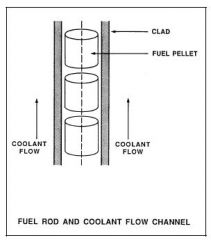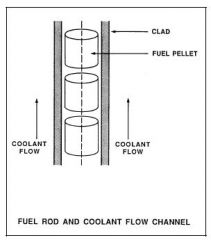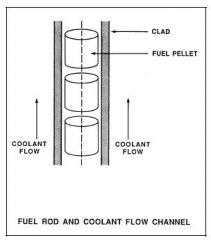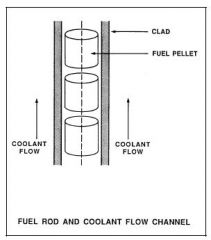![]()
![]()
![]()
Use LEFT and RIGHT arrow keys to navigate between flashcards;
Use UP and DOWN arrow keys to flip the card;
H to show hint;
A reads text to speech;
32 Cards in this Set
- Front
- Back
|
A nuclear reactor is operating at 75 percent power at the middle of a fuel cycle with radial power distribution peaked in the center of the core. All control rods are fully withdrawn and in manual control. Assuming all control rods remain fully withdrawn, except as noted, which one of the following will cause the maximum steady-state radial peaking (or hot channel) factor to decrease? A. Turbine load/reactor power is reduced by 20 percent. B. A control rod located at the edge of the core drops into the core. C. Reactor coolant system boron concentration is reduced by 10 ppm. D. The reactor is operated continuously at 75 percent power for three months.
|
D.
|
|
|
A nuclear reactor is operating at 80 percent power near the middle of a fuel cycle. All control rods are fully withdrawn and in manual control. Core axial power distribution is peaked below the core midplane. Which one of the following will significantly decrease the core maximum axial peaking (or hot channel) factor? (Assume no subsequent operator action is taken and that main turbine load and core xenon distribution do not change unless stated.) A. One bank of control rods is inserted 10 percent. B. One control rod fully inserts into the core. C. Turbine load/reactor power is reduced by 20 percent. D. Reactor coolant system boron concentration is reduced by 50 ppm.
|
C.
|
|
|
A PWR core consists of 50,000 fuel rods; each fuel rod has an active length of 12 feet. The core is producing 1,800 MW of thermal power. If the nuclear heat flux hot channel factor, FQ(z), (also called the total core peaking factor) is 2.0, what is the maximum local linear power density being produced in the core? A. 4.5 kW/ft B. 6.0 kW/ft C. 9.0 kW/ft D. 12.0 kW/ft
|
B.
|
|
|
A PWR core consists of 50,000 fuel rods; each fuel rod has an active length of 12 feet. The core is producing 1,800 MW of thermal power. If the nuclear heat flux hot channel factor, FQ(z), (also called the total core peaking factor) is 1.5, what is the maximum local linear power density being produced in the core? A. 4.5 kW/ft B. 6.0 kW/ft C. 9.0 kW/ft D. 12.0 kW/ft
|
A.
|
|
|
A PWR core consists of 50,000 fuel rods; each fuel rod has an active length of 12 feet. The core is producing 1,800 MW of thermal power. If the nuclear heat flux hot channel factor, FQ(z), (also called the total core peaking factor) is 3.0, what is the maximum local linear power density being produced in the core? A. 4.5 kW/ft B. 6.0 kW/ft C. 9.0 kW/ft D. 12.0 kW/ft
|
C.
|
|
|
A nuclear reactor is operating at 3,400 MW thermal power. The core linear power density limit is 12.2 kW/ft. Given: C The reactor core contains 198 fuel assemblies. C Each fuel assembly contains 262 fuel rods, each with an active length of 12.0 feet C The highest total peaking factors measured in the core are as follows: Location A: 2.5 Location B: 2.4 Location C: 2.3 Location D: 2.2 Which one of the following describes the operating conditions in the core relative to the linear power density limit? A. All locations in the core are operating below the linear power density limit. B. Location A has exceeded the linear power density limit while the remainder of the core is operating below the limit. C. Locations A and B have exceeded the linear power density limit while the remainder of the core is operating below the limit. D. Locations A, B, and C have exceeded the linear power density limit while the remainder of the core is operating below the limit.
|
D.
|
|
|
A nuclear reactor is operating at steady state conditions in the power range with the following average temperatures in a core plane: Tcoolant = 550EF Tfuel centerline = 1,680EF Assume that the fuel rod heat transfer coefficients and reactor coolant temperatures are equal throughout the core plane. If the maximum total peaking factor in the core plane is 2.1, what is the maximum fuel centerline temperature in the core plane? A. 2,923EF B. 3,528EF C. 4,078EF D. 4,683EF
|
A.
|
|
|
The basis for the maximum power density (kW/foot) power limit is to... A. provide assurance of fuel integrity. B. prevent xenon oscillations. C. allow for fuel pellet manufacturing tolerances. D. prevent nucleate boiling.
|
A.
|
|
|
If a nuclear reactor is operated within core thermal limits, then... A. plant thermal efficiency is optimized. B. fuel cladding integrity is ensured. C. pressurized thermal shock will be prevented. D. reactor vessel thermal stresses will be minimized.
|
B.
|
|
|
The 2,200EF maximum peak fuel cladding temperature limit is imposed because... A. 2,200EF is approximately 500EF below the fuel cladding melting temperature. B. the rate of the zircaloy-steam reaction increases significantly at temperatures above 2,200EF. C. any cladding temperature higher than 2,200EF correlates to a fuel centerline temperature above the fuel melting point. D. the thermal conductivity of zircaloy decreases rapidly at temperatures above 2,200EF.
|
B.
|
|
|
During normal operation, fuel clad integrity is ensured by... A. the primary system relief valves. B. core bypass flow restrictions. C. the secondary system relief valves. D. operating within core thermal limits.
|
D.
|
|
|
Maximum fuel cladding integrity is attained by... A. always operating below 110 percent of reactor coolant system design pressure. B. actuation of the reactor protection system upon a reactor accident. C. ensuring that actual heat flux is always less than critical heat flux. D. ensuring operation above the critical heat flux during all operating conditions.
|
C.
|
|
|
Nuclear reactor core peaking (or hot channel) factors are used to establish a maximum reactor power level such that fuel pellet temperature is limited to prevent _________ and fuel clad temperature is limited to prevent ________ during most analyzed transients and abnormal conditions. A. fuel pellet melting; fuel clad melting B. excessive fuel pellet expansion; fuel clad melting C. fuel pellet melting; excessive fuel clad oxidation D. excessive fuel pellet expansion; excessive fuel clad oxidation
|
C.
|
|
|
Nuclear reactor thermal limits are established to... A. ensure the integrity of the reactor fuel. B. prevent exceeding reactor vessel mechanical limitations. C. minimize the coolant temperature rise across the core. D. establish control rod insertion limits.
|
A.
|
|
|
Thermal limits are established to protect the nuclear reactor core, and thereby protect the public during plant operations which include... A. normal operations only. B. normal and abnormal operations only. C. normal, abnormal, and postulated accident operations only. D. normal, abnormal, postulated and unpostulated accident operations.
|
C.
|
|
|
Which one of the following describes the basis for the 2,200EF maximum fuel clad temperature limit? A. 2,200EF is approximately 500EF below the fuel clad melting temperature. B. The material strength of zircaloy decreases rapidly at temperatures above 2,200EF. C. The rate of the zircaloy-water reaction becomes significant at temperatures above 2,200EF. D. At the normal operating pressure of the reactor vessel a clad temperature above 2,200EF indicates that the critical heat flux has been exceeded.
|
C.
|
|
|
Given the following initial core parameters for a segment of a fuel rod: Power density = 3 kW/ft Tcoolant = 579EF Tfuel centerline = 2,400EF Reactor power is increased such that the following core parameters now exist for the same fuel rod segment: Power density = 5 kW/ft Tcoolant = 590EF Tfuel centerline = ? Assuming no boiling occurs and coolant flow rate is unchanged, what will be the new stable Tfuel centerline? A. 3,035EF B. 3,614EF C. 3,625EF D. 4,590EF
|
C.
|
|
|
Which one of the following describes the basis for the 2,200EF maximum fuel clad temperature limit? A. 2,200EF is approximately 500EF below the fuel clad melting temperature. B. The rate of the zircaloy-steam reaction increases significantly above 2,200EF. C. If fuel clad temperature reaches 2,200EF, the onset of transition boiling is imminent. D. The differential expansion between the fuel pellets and the fuel clad becomes excessive above 2,200EF.
|
B.
|
|

Refer to the drawing of a fuel rod and coolant flow channel at beginning of core life (see figure below). Given the following initial core parameters: Reactor power = 100 percent Tcoolant = 500EF Tfuel centerline = 3,000EF What would the fuel centerline temperature be if, over core life, the total fuel-to-coolant thermal conductivity were doubled? (Assume reactor power is constant.) A. 2,000EF B. 1,750EF C. 1,500EF D. 1,250EF
|
B.
|
|
|
The pellet-to-clad gap in fuel rod construction is designed to... A. decrease fuel pellet slump. B. reflect fission neutrons. C. increase heat transfer rate. D. reduce internal clad strain.
|
D.
|
|

Refer to the drawing of a fuel rod and coolant flow channel (see figure below) at beginning of core life. Given the following initial core parameters: Reactor power = 100 percent Tcoolant = 500EF Tfuel centerline = 2,500EF What would the fuel centerline temperature be if, over core life, the total fuel-to-coolant thermal conductivity were doubled? (Assume reactor power is constant.) A. 1,000EF B. 1,250EF C. 1,500EF D. 1,750EF
|
C.
|
|
|
A nuclear reactor is operating at 80 percent power with all control rods fully withdrawn and in manual control. Compared to a 50 percent insertion of one control rod, 50 percent insertion of a group (or bank) of control rods will cause a ______________ increase in the steady state core maximum axial power peaking factor and a ______________ increase in the steady state core maximum radial power peaking factor. (Assume reactor power remains constant.) A. smaller; smaller B. smaller; larger C. larger; smaller D. larger; larger
|
C.
|
|
|
Refer to the drawing of a fuel rod and coolant flow channel at the beginning of core life (see figure below). Given the following initial core parameters: Reactor power = 100 percent Tcoolant = 500EF Tfuel centerline = 2,700EF Which one of the following will be the fuel centerline temperature at the end of core life if the total fuel-to-coolant thermal conductivity doubles? (Assume reactor power is constant.) A. 1,100EF B. 1,350EF C 1,600EF D. 1,850EF
|
C.
|
|
|
A nuclear reactor is operating at 80 percent power with all control rods fully withdrawn. Compared to a 50 percent insertion of a group (or bank) of control rods, 50 percent insertion of a single control rod will cause a ______________ increase in the axial peaking hot channel factor and a ______________ increase in the radial peaking hot channel factor. (Assume reactor power remains constant.) A. larger; smaller B. larger; larger C. smaller; smaller D. smaller; larger
|
D.
|
|
|
Which one of the following describes the fuel-to-coolant thermal conductivity at the end of core life (EOL) as compared to the beginning of core life (BOL)? A. Smaller at EOL due to fuel pellet densification. B. Smaller at EOL due to contamination of fill gas with fission product gases. C. Larger at EOL due to reduction in gap between fuel pellets and clad. D. Larger at EOL due to greater temperature difference between fuel pellets and coolant.
|
C.
|
|
|
Refer to the drawing of a fuel rod and coolant flow channel at the beginning of core life (see figure below). Given the following initial core parameters: Reactor power = 60 percent Tcoolant = 540EF Tfuel centerline = 2,540EF Which one of the following will be the fuel centerline temperature at the end of core life if the total fuel-to-coolant thermal conductivity doubles? (Assume reactor power is constant.) A. 1,270EF B. 1,370EF C. 1,440EF D. 1,540EF
|
D.
|
|
|
Which one of the following describes the fuel-to-coolant thermal conductivity for a fuel assembly at the beginning of a fuel cycle (BOC) as compared to the end of a fuel cycle (EOC)? A. Larger at BOC due to a higher fuel pellet density. B. Larger at BOC due to lower contamination of fuel rod fill gas with fission product gases. C. Smaller at BOC due to a larger gap between the fuel pellets and clad. D. Smaller at BOC due to a smaller corrosion film on the surface of the fuel rods.
|
C.
|
|
|
Refer to the drawing of a fuel rod and coolant flow channel at the beginning of core life (see figure below). Given the following initial core parameters: Reactor power = 60 percent Tcoolant = 560EF Tfuel centerline = 2,500EF Which one of the following will be the fuel centerline temperature at the end of core life if the total fuel-to-coolant thermal conductivity doubles? (Assume reactor power is constant.) A. 1,080EF B. 1,250EF C. 1,530EF D. 1,810EF
|
C.
|
|

Refer to the drawing of a fuel rod and coolant flow channel at beginning of core life (see figure below). The nuclear reactor is shut down with the following parameter values: Tcoolant = 320EF Tfuel centerline = 780EF What would the fuel centerline temperature be under these same conditions at the end of core life if the total fuel-to-coolant thermal conductivity were doubled? A. 550EF B. 500EF C. 450EF D. 400EF
|
A.
|
|
|
Refer to the drawing of a fuel rod and coolant flow channel (see figure below). The nuclear reactor is shut down at the beginning of a fuel cycle with the following average parameter values: Tcoolant = 440EF Tfuel centerline = 780EF If the total fuel-to-coolant thermal conductivity doubles over core life, what will the fuel centerline temperature be with the same coolant temperature and reactor decay heat conditions at the end of the fuel cycle? A. 610EF B. 580EF C. 550EF D. 520EF
|
A.
|
|
|
Refer to the drawing of a fuel rod and coolant flow channel at the beginning of core life (see figure below). Given the following initial core parameters: Reactor power = 50 percent Tcoolant = 550EF Tfuel centerline = 2,750EF What will the fuel centerline temperature be if, over core life, the total fuel-to-coolant thermal conductivity doubles? (Assume reactor power and Tcoolant are constant.) A. 1,100EF B. 1,375EF C. 1,525EF D. 1,650EF
|
D.
|
|

Refer to the drawing of a fuel rod and coolant flow channel (see figure below). Given the following initial stable core parameters: Reactor power = 50 percent Tcoolant = 550EF Tfuel centerline = 2,250EF Assume that the total heat transfer coefficient and the reactor coolant temperature do not change. What will the approximate stable fuel centerline temperature be if reactor power is increased to 75 percent? A. 2,550EF B. 2,800EF C. 2,950EF D. 3,100EF
|
D.
|

